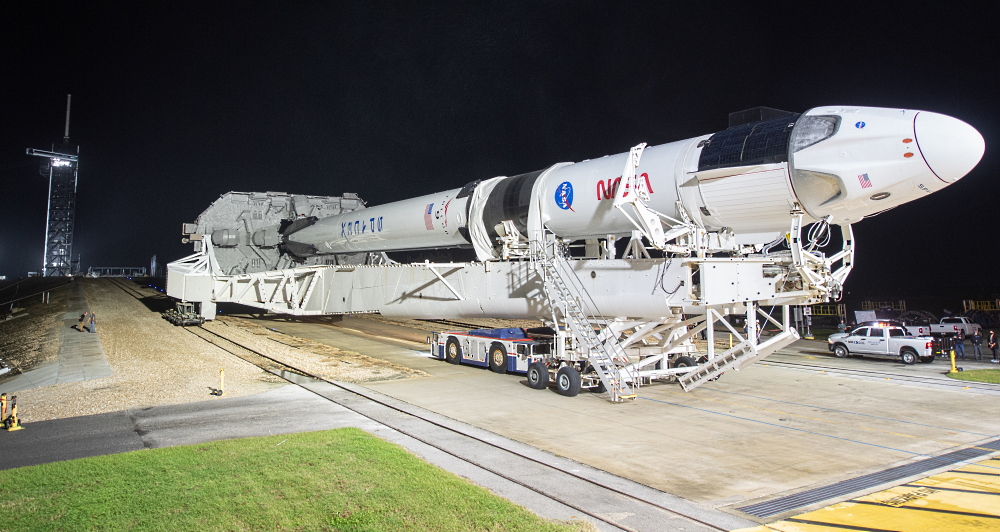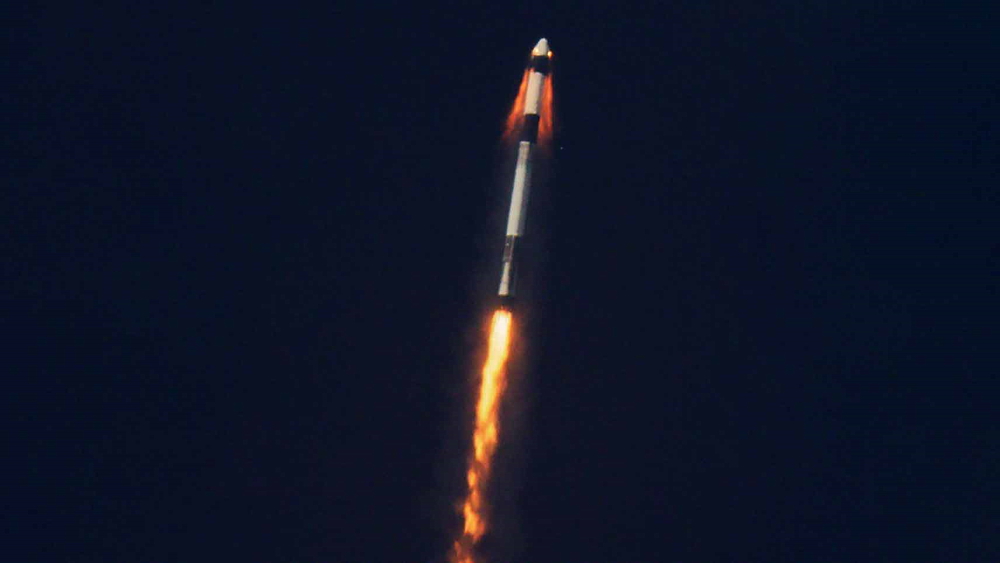
Removal of the launch vehicle with the spacecraft at the start, photo by NASA
What cancels the launch
The first attempt to launch the Crew-1 mission on November 14 was postponed for a day due to weather conditions - coastal wind and tropical storm Eta, which delayed the exit from the port and arrival at the calculated point of the barge for landing the first stage. And the list of weather conditions due to which the launch of the Falcon 9 launch vehicle with the manned spacecraft Crew Dragon is canceled is presented on the NASA website. There are quite a few factors: the

rocket and the spacecraft before launch on May 30, photo by NASA / Bill Ingalls
Strong winds exceeding 48 km / h at the 50-meter mark (altitude) of the launch complex, or high-altitude wind shear (a phenomenon when with a slight increase in altitude the wind changes force or direction) means the start is canceled.
Lightning , thunderstormor a thundercloud are also unacceptable. Lightning detected within a radius of 16 km postpones the launch for at least 30 minutes, except for special conditions. The same radius of 16 km (ie 10 miles) applies to thunderclouds with a characteristic "anvil". Also unacceptable are cumulus clouds formed by a pillar of smoke or connected to the ground through such a pillar. Icing
conditions also cancel the launch - the rocket route cannot pass through a 1.3 km thick cloud, which reaches an altitude where the temperature is below zero, or, without special conditions, generally pass next to a cloud, the upper part of which is in the zone of negative temperatures. Electrostatic Fluxmeter

The photo shows an electrostatic fluxmeter, a special device that measures the strength of an electrostatic field, or, in simple terms, how electrified the atmosphere is. At Cape Canaveral, there are three dozen such devices, and one showing a value of more than 1500 volts per meter is enough to cancel the launch. 1000 volts per meter is acceptable under specific conditions.
Also, the weather is monitored in about 50 sections along the flight route - unacceptable values of wind, waves, precipitation at a point that can become an emergency landing site also cancel the launch.
It is worth noting that these restrictions have been formed throughout the history of American astronautics and are not associated with a specific ship or rocket. For example, before Apollo 12, which was struck by lightning, the only prohibition concerning the danger of atmospheric discharges was a prohibition on flying directly through a thundercloud. The restrictions also had to be tightened after a lightning strike in 1987 led to a wrong turn command and the destruction of the Atlas-Centaur launch vehicle in the air. And experiments with fluxmeters in 1990-1992 made it possible, on the contrary, to weaken the restrictions somewhat, allowing the passage through clouds, the upper part of which has a temperature of -5 ° C (before that it was + 5 ° C).
Emergency modes

Tests of the rescue system in flight, photo by SpaceX The
emergency modes of the space shuttle had their names - RTLS (return to launch), TAL (landing on the other side of the Atlantic Ocean), ATO (emergency mode with entry into orbit). Crew Dragon uses Apollo style numbering from 1a to 2e.
1a starts at the start time (0:00). In the event of an accident with the launch vehicle, the ship will separate from it and go to the side on eight SuperDraco engines. Then the orientation engines will turn it upside down in the direction of flight, and the parachute system will open immediately or, if the ship has already climbed high, in the process of descending at a standard height. The ship will have to splash down on a line from Florida to North Carolina.
1bactivates at 01:15 and differs only in the splashdown area off the coast of Virginia.
The longest mode 2a starts at 02:36, in the area of the first stage separation, and lasts until the beginning of the ninth minute of flight. In this case, the ship will turn on its engines to aim at a specific emergency landing point in the North Atlantic.
2b should fire at 08:05, in which case the ship will turn around and slow down to splash down at an emergency landing point near the Canadian province of Nova Scotia.
Turn 2c will arrive at 08:29 and the ship will accelerate to reach the landing area near Ireland.
For 2D starting at 08:39 the landing area will be the same, but the ship will have to slow down.
And the very last and shortest mode 2e , which is active for the last two seconds of the flight - 08: 49-08: 50, is an analogue of the ATO of the shuttle - the spacecraft will be put into orbit with its engines and continue its flight.
general information
The SpaceX Crew-1 mission, also known as USCV-1 or simply Crew-1, is the first non-test flight of the Crew Dragon spacecraft to the International Space Station. Four astronauts, Michael Hopkins, Victor Glover, Soichi Noguchi (JAXA) and Shannon Walker, are to join the already working on the ISS Russians Sergey Ryzhikov, Sergey Kud-Sverchkov and American Kathleen Rubins and work at the station for the usual six-month shift.
The stages of a typical flight of the Crew Dragon spacecraft to the ISS can be viewed from the reconstruction in the Orbiter simulator using the example of the DM-2 test mission.